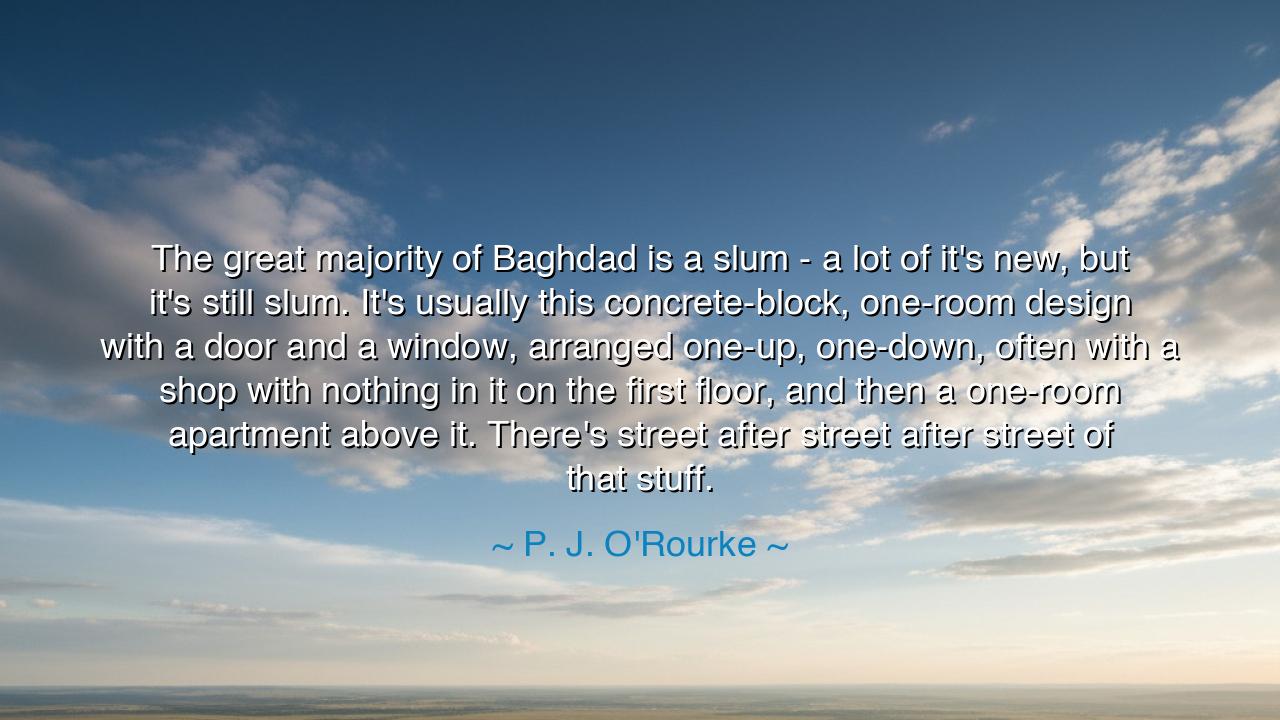
The great majority of Baghdad is a slum - a lot of it's new, but
The great majority of Baghdad is a slum - a lot of it's new, but it's still slum. It's usually this concrete-block, one-room design with a door and a window, arranged one-up, one-down, often with a shop with nothing in it on the first floor, and then a one-room apartment above it. There's street after street after street of that stuff.






“The great majority of Baghdad is a slum — a lot of it's new, but it's still slum. It's usually this concrete-block, one-room design with a door and a window, arranged one-up, one-down, often with a shop with nothing in it on the first floor, and then a one-room apartment above it. There's street after street after street of that stuff.” — P. J. O’Rourke
In these stark and unsparing words, P. J. O’Rourke, the sharp-eyed journalist and satirist, lifts the veil on the modern tragedy of civilization: the widening gulf between the appearance of progress and the reality of poverty. When he describes Baghdad — ancient city of empires, cradle of learning and culture — reduced to endless rows of concrete-block dwellings, he is not mocking the poor, but mourning the broken promise of modernity. The image is vivid and painful: the shop “with nothing in it,” the room “with only a door and a window.” It is a vision of hope without fulfillment, of human dignity constrained within walls of gray cement.
To understand the power of these words, one must remember that Baghdad was once the jewel of the Islamic Golden Age — a city where poets, scholars, and architects gave form to humanity’s highest aspirations. Under the Abbasid Caliphs, it was the beating heart of knowledge, home to the House of Wisdom, where Greek philosophy, Persian science, and Arab ingenuity met and merged. Its libraries illuminated the darkened corners of the world. Yet O’Rourke, writing after years of war and devastation, sees a city stripped of its grandeur — a shadow of its past, where the architecture of survival replaces the architecture of beauty. The city that once built domes and gardens now builds walls and windows — symbols not of creation, but of endurance.
O’Rourke’s observation is not merely about Baghdad; it is about the fate of countless cities across the modern world — where urban growth outpaces the soul of civilization. Concrete replaces culture, and buildings rise without vision. The slum, as he calls it, is not only a physical condition but a spiritual one — a manifestation of how humanity has learned to survive without truly living. Each “one-room design,” each “shop with nothing in it,” becomes a metaphor for the emptiness that follows when progress forgets its purpose. These are not just structures; they are the silent prayers of those who build but cannot belong.
The ancients knew that architecture was not mere shelter, but a reflection of the soul. In Athens, in Rome, in ancient Baghdad itself, the shape of a city revealed the character of its people. The Greeks raised temples to embody their pursuit of reason; the Romans built roads to declare their order; the builders of Baghdad erected domes and courtyards that mirrored their harmony with the divine. But now, as O’Rourke witnesses, the form of the city reveals not pride, but poverty — not community, but fragmentation. Where once stood palaces of thought, now stand walls of necessity.
Yet even in this bleak description lies a spark of truth worth cherishing. For within these “streets after street after street” of sameness live men and women who continue to hope. Even in the humblest home, there are dreams — dreams of stability, of peace, of purpose. The “shop with nothing in it” may one day open its doors to trade again; the one-room dwelling may one day echo with laughter instead of silence. O’Rourke’s realism, though hard and unsentimental, does not extinguish the possibility of renewal. It reminds us that even amid desolation, humanity’s resilience endures.
We can see this truth in history’s countless rebirths. After the ashes of World War II, cities like Berlin and Tokyo rose again, rebuilt not merely with steel and stone, but with will and vision. They were places once flattened into hopelessness, yet they became symbols of renewal because their people refused to let ruins define them. The same hope lives in the Baghdad O’Rourke describes — though its streets may seem lifeless, its spirit waits to be rekindled. For civilizations, like individuals, fall not when they are wounded, but when they stop believing in their power to heal.
Lesson:
From P. J. O’Rourke’s words, we learn that the measure of a city — and indeed of humanity — is not in its buildings, but in its soul. A civilization that builds without meaning, that raises walls but forgets beauty, risks becoming a slum in spirit even if it shines in wealth. To heal such a world, we must remember that progress is not the piling of concrete but the cultivation of dignity — in art, in education, in compassion. Each of us is a builder of some kind: of homes, of businesses, of dreams. Let us then build not merely for function, but for hope. For when we design our world to lift the spirit and not just house the body, even the humblest street can become a city of light, and even the ruins of history can give birth again to greatness.






AAdministratorAdministrator
Welcome, honored guests. Please leave a comment, we will respond soon